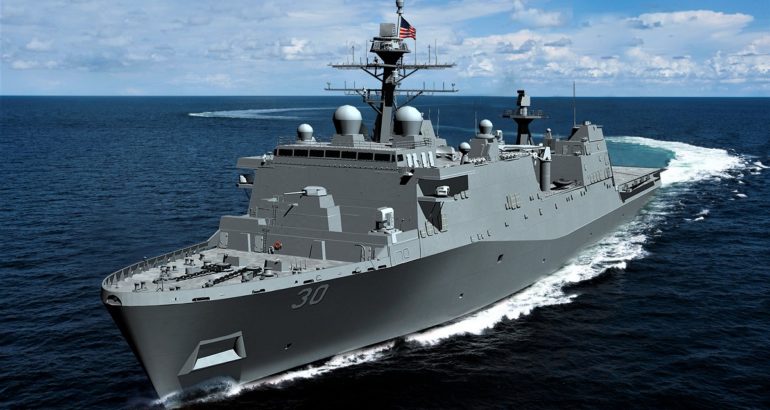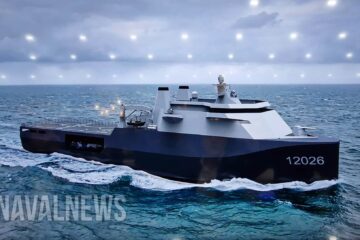VLS was reported by Tom Clancy but wasn’t implemented.
Peter Ong story with additional reporting by Xavier Vavasseur.
Twenty-five years ago, the late author, Tom Clancy, a fictional war-thriller and non-fictional military historian and weapons systems analyst, wrote in his non-fiction analyst book, MARINE, A Guided Tour of a Marine Expeditionary Unit (Publisher: Berkeley and PengiunRandomHouse, November 1, 1996), the following:
“Another issue is active defensive measures. While the armament package of the LPD-17 class is still under study, likely weapons systems have been identified. Up forward, room is allocated for a sixteen-cell Mk 41 vertical launch system (VLS), like those on Spruance-class (DD-963) destroyers, Ticonderoga-class (CG-47) cruisers, and Arleigh Burke-class (DDG-51) destroyers.
“While this would theoretically allow the LPD-17s to fire RIM-66 Standard SAMs and BGM-109 Tomahawk cruise missiles, the primary weapons system being considered for the VLS launcher is the new Enhanced Sea Sparrow Missile (ESSM). Packaged into four-round launch canisters (for a total of forty-eight ESSM missiles), these will provide the LPD-17 with better anti-air and anti-missile defense than the existing RIM-7 Sea Sparrow.
“The LPD-17 will probably carry a pair of Ex-31 RAM launchers (each with twenty-one ready missiles) as well as a pair of 20mm CIWS for last-ditch defense against incoming “leaker” missiles and aircraft.
“Finally, there will probably be a pair of Mk 38 25mm Bushmaster cannon mounts, and mounts for four M2 .50 caliber machine guns to deal with small craft and swimmers (such as enemy frogmen).
“The LPD-17s will be the most heavily armed amphibious ships built since World War II. Backing up all this firepower will be a new “Cooperative Engagement Capability” (CEC).”
Tom Clancy, MARINE, 1996
Four years after Tom Clancy published his LPD-17’s armament prediction, construction on the first LPD-17, USS San Antonio, started on December 9, 2000. According to the Naval Sea Systems Command (NAVSEA) U.S. Navy’s Fact Sheet, the actual armament of the LPD-17s as of January 2021, consists of:
- (2) Rolling Airframe Missile (RAM) Launchers [As described by Tom Clancy]
- (2) 30mm Guns [Not MK38 25mm Bushmaster cannons, but the prediction was similar as it is a pair]
- (10) .50 Caliber Machine Guns [instead of four envisioned]
[CEC is now a U.S. Navy reality with most ships having it]
The envisioned MK41 VLS and Evolved Sea Sparrow Missiles (ESSMs) were never fitted into the LPD-17s, and U.S. Navy statements indicate that these VLS-reserved hull spaces were used for other purposes, meaning that VLS tubes cannot be installed. Breaking Defense validates this story.
Whatever happened to that VLS-reserved LPD-17 hull space that Tom Clancy wrote twenty-five years ago was not disclosed by the Navy because not even one VLS or ESSM tube has been installed in the LPD-17 San Antonio Amphibious Transport Dock ships.
The lack of long-range LPD-17 armament becomes a problem in almost any conflict (let alone against peer nations) that has warships armed with Anti-ship missiles because the LPD-17 often sails accompanied with a Landing Helicopter Dock (LHD, such as the Wasp-class) or Landing Helicopter Assault (LHA, such as the America-class) helicopter transport ship and a Dock Landing Ship (LSD such as the Whidbey Island-class) that comprise the U.S. Navy/Marine Amphibious Ready Group (ARG).
The “Armed shotgun-riding” warship would usually be an AEGIS Arleigh Burke destroyer with 90-96 VLS launch tubes that acts as the ARG’s protector (and the number of Burke destroyers employed depends on the Readiness numbers). If the AEGIS destroyer was damaged, sunk, or called away, the large amphibious ships might be in trouble due to their lack of long-range offensive firepower and organic fire support options for the U.S. Marines ashore (the LHA and LHD designs no longer have 5-inch naval guns designed into their forward corners like the Tarawa-class Landing Helicopter Assaults (these 5-inch guns were removed in 1997-1998).
Until the Constellation-class Future Frigate (FFG(X)) enters service with its 32 VLS tubes, the Arleigh Burkes will still play the essential role of protectors to the ARG. As the NAVSEA Fact Sheet shows, the LPD-17s were built with limited defensive self-protection armament against incoming missiles, swimmers, and small boats and with no medium to long-range offensive strike guns or missiles. As a forward-deployed, self-power projection frontline large Amphibious warship, the lack of LPD-17 distance firepower could become a commander’s concern and liability in a fight against a competitive and competent foe.
The Plan to Incorporate Offensive Missiles for the LPD-17s

USNI news reported in 2016 about the possibility of the LPD-17 Flight IIs mounting VLS tubes in that reserved bow space reported by Tom Clancy. Five years later in early 2021, the LPD-17 Flight IIs still do not have VLS installed.
On January 10th, 2021, SEAPOWER reported that the U.S. Navy plans to incorporate a longer-range offensive missile type into the LPD-17’s armament.
At the Surface Navy Association (SNA 2021) Virtual Symposium on Tuesday, January 12, 2021, Naval News asked Major General Tracy W. King for clarification as to what kind of offensive missiles are envisioned for the LPD-17s, and how will they be implemented. Major General King replied that he wasn’t concerned so much about the “Material Solutions” (the type of missile(s)) used, and was more concerned about setting the Requirements to offer to the Defense Industry to determine the best Material Solution:
“Do we need Fixed-Box launchers [inside the LPD-17 hulls]? No. …the future is `missiles in a box.’“
Major General Tracy W. King at SNA 2021
Several non-VLS ship-mounted options are available, however, namely considering how the longer-range missile launcher is mounted. If the missile is to be fired from the large helicopter’s Flight Deck, U.S. Marine Corps HiMARS, or Shipping Cargo Container Modules (what Major General King alluded to), and towed flatbed trailer box launchers could be an option. Unless fixed in place for the ARG’s tour-of-duty, any trailer-mounted missile launcher requires a Prime Mover, namely a semi-tractor to tow it. With the near-future manufacture of electric semi tractors, the towed-trailer option might be selected to avoid diesel exhaust fumes inside the Amphibious ship.
At SNA 2021, Major General King “leans” towards implementing the Naval Strike Missile for the LPD-17 due to recent fitting, testing, and firing on the Littoral Combat Ship, USS Gabrielle Giffords; however, that is not the permanent solution as that solution is left open. King said that he envisions every ship to be a “shooter” and “if it increases lethality, it increases survivability.” Furthermore, the Marine General stated that the study and testing of the missile type, in addition to the future fiscal budgets will influence and determine the “Material Solution” implemented into the LPD-17.

Other Possible “Material (Firepower) Solutions” for the LPD-17s
For purely speculative purposes, Naval News explores other LPD-17 “increased Lethality options.”
Lockheed Martin Joint Quad Launcher (JQL)

One option might be to mount Lockheed’s Joint Quad Launcher (JQL) for the Joint Air-to-Ground Missile (JAGM), essentially a replacement of the Longbow Hellfire Anti-Tank Guided Missile (ATGM). JAGM offers a dual-homing semi-active laser and millimeter-wave radar seeker in one missile compared to swapping out Longbow Hellfires for either the laser-guided or the radar-homing seeker missile variant. Lockheed Martin told Naval News that JQL is slated for a ground-launch testing in the middle of 2021, pending COVID scheduling.
With JQL/JAGM, the missile range is short, respectably, about five miles, or eight kilometers, just over-the-horizon. The benefit of JQL is that it doesn’t require emplacement into the hull of the ship and JQL can support the Marines ashore with ATGM fire while the longer-range strike missiles such as Naval Strike Missiles, HiMARS, or missiles fired from trailers could be used in the land and ship attack roles. JQL’s deck footprint is narrow, allowing for more quad-tubes to be mounted.
U.S. Army’s MML

Another simpler-than-MK41 VLS option might be to mount the U.S. Army’s Multi-Mission Launcher (MML), another compact 15-cell VLS box that doesn’t drill into the hull of the ship. MML can sit on topside deck and fire the Longbow Hellfire, JAGM, AIM-9X Sidewinder (Sidewinder’s range is around 20+ miles/32km and it does have a dual Anti-Air and ground attack capability), and the Tamir/SkyHunter missile (better known as Israeli’s “Iron Dome”) with a 43mi/70km range. A few MMLs could provide LPD-17s with a competent VLS system.
Additional guidance and fire control sensors may be required for LPD-17 with JQL/JAGM or U.S. Army MML VLS missile operation.
BAE Systems Adaptable Deck Launcher

Designed by BAE Systems, the Adaptable Deck Launcher, or ADL, meets the need for a fixed angle, low elevation, deck-mounted ship defense launching system (SDLS) for near-term application onboard U.S. Navy and allied ships. The ADL is fully compatible with the Evolved SeaSparrow Missile (ESSM), in the Mk 25 Quad Pack Canister, as well as other canisters compatible with the Mk 41 VLS. Launch control can be provided by the Mk 41 VLS electronics suite and other launch control systems.
In Proof of Concept demonstrations, ADL successfully launched an ESSM from an ADL-enclosed Mk 25 Quad Pack Canister, verifying that ADL meets requirements for missile egress and gas management and provides adequate launcher structural support, while proving applicability of a Mk 41 VLS Launch Control System variant for SDLS operation.
This identical approach also applies to other missiles and missions including Surface Strike, Air Defense, and Anti-submarine warfare. The ADL answers the call for Distributed Lethality and Distributed Maritime Operations for platforms big and small. According to the BAE Systems “Direct applications include LCS, FFG(X) as well as big deck amphibious ships and carriers”.






